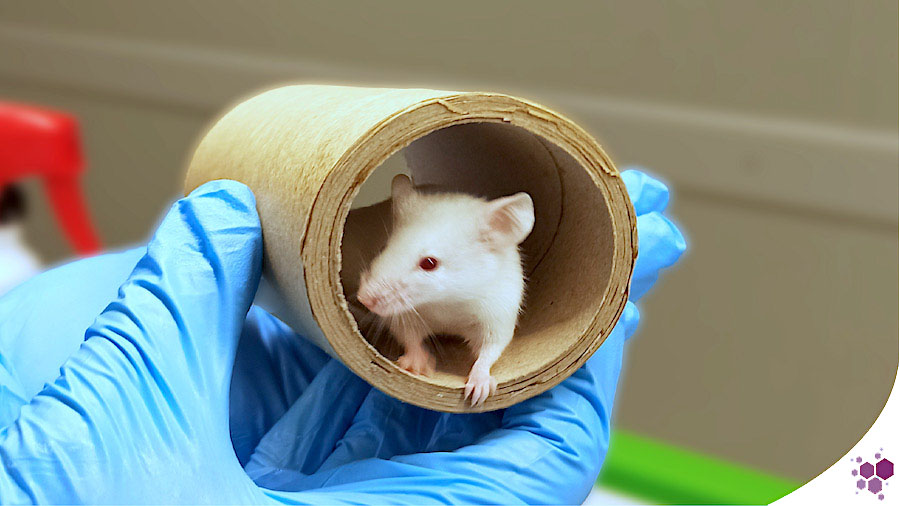Mice are the most commonly used species in animal experimentation. To carry out research protocols, experimenters need to catch and handle them efficiently for health conditions assessments or treatments administrations.
Mice are prey animals and naturally fear humans, whom they perceive as predators (Blanchard et al., 2001). Consequently, a mouse typically feels anxious during interactions with humans. However, the stress levels of these interactions can vary. The stress levels mice experience during handling are significantly influenced by the method used and the extent to which they are familiarized with human contact.
Laboratory mice are typically purchased from certified suppliers or bred locally if the institution has a breeding program. Since laboratory mice differ from wild mice, they are generally docile and easy to manage. While rare, there are instances where an experimenter might be bitten. In such cases, the experimenter should control their pain response to avoid a reflexive reaction that could injure the mouse. Most bites tend to occur when experimenters are learning new technical procedures or are themselves stressed.
Methods to Capture a Mouse
The traditional technique for capturing a mouse involves grasping the base of the tail and lifting it. Although this method is relatively painless for the mouse (assuming the tail’s end isn’t grasped), it is known to cause high stress levels. As a result, more humane methods have been developed to reduce stress (Gouveia & Hurst, 2019). Since stress increases with tail suspension, experimenters can mitigate this by supporting the mouse with their hand while lifting.
Alternative methods, such as cup handling and tunnel handling, are now recommended. These techniques don’t involve grabbing the tail. Instead, mice are coaxed to climb onto cupped hands or into a tunnel, a common enrichment item in mouse cages. A gradual acclimation process over several days is essential. Experimenters should gently encourage mice to use these supports without forcing or chasing them, which could increase stress. Once acclimated, these methods are as efficient as tail handling (Marcotte et al., 2021).
Practices and recommendations have evolved over the past few decades. While animal welfare was once an afterthought in tail handling, today, there’s a significant emphasis on handling mice gently, allowing them as much freedom of movement as possible (Donovan & Brown, 2013; National Centre for the Replacement, Refinement & Reduction of Animals in Research)
Acclimation to Handling
Another strategy to reduce handling stress is acclimation or desensitization. Mice are gradually introduced to non-invasive human interaction. Various protocols exist, each tailored to specific research needs. For example, on the first day of acclimation, an experimenter might place their hand in the mouse cage, letting the mice explore and become familiar with the human or glove scent. The next day, the experimenter can touch the mice without lifting them. Over time, the experimenter gently lifts each mouse, holding them until they calm down, possibly by gently stroking their head or back. After several sessions, mice become used to being held, sometimes even grooming themselves. This acclimation results in more relaxed mice during handling, thereby easing the experimenter’s job and reducing stress for both mice and humans (Swan et al., 2023).
In conclusion, refining capture methods and acclimating mice to handling not only streamlines experimental procedures but also ensures a less stressful experience for both mice and humans.
TransCure bioServices, proudly accredited by AAALAC, is deeply committed to upholding the highest standards in animal care and research. Our dedication goes beyond just compliance; we continuously strive for excellence in every aspect of our work. Central to this mission is our relentless effort to train our team in the best practices. We believe that by ensuring our team is well-equipped with the latest knowledge and techniques, we can provide the utmost care for the animals and deliver accurate, reliable research outcomes. At TransCure bioServices, our dedication to ethical and effective research practices is unwavering, and we take pride in leading the way in humane and responsible animal experimentation.
Interested to learn more? Do not hesitate to contact us!
References:
Blanchard, D. C., Griebel, G., Blanchard, R. J., & Blanchard, D. C. (2001). Mouse defensive behaviors: pharmacological and behavioral assays for anxiety and panic.
Donovan, J., & Brown, P. (2013). Care and handling of laboratory mice. Current Protocols in Microbiology, SUPPL.31.
Gouveia, K., & Hurst, J. L. (2019). Improving the practicality of using non-aversive handling methods to reduce background stress and anxiety in laboratory mice. Scientific Reports, 9(1).
Marcotte, M., Bernardo, A., Linga, N., Pérez-Romero, C. A., Guillou, J.-L., Sibille, E., & Prevot, T. D. (2021). Handling Techniques to Reduce Stress in Mice. Journal of Visualized Experiments, 175.
National Centre for the Replacement Refinement & Reduction of Animals in Research. (n.d.). Mouse handling. NC3Rs. Retrieved July 11, 2023.
Swan, J., Boyer, S., Westlund, K., Bengtsson, C., Nordahl, G., & Törnqvist, E. (2023). Decreased levels of discomfort in repeatedly handled mice during experimental procedures, assessed by facial expressions. Frontiers in Behavioral Neuroscience, 17.

